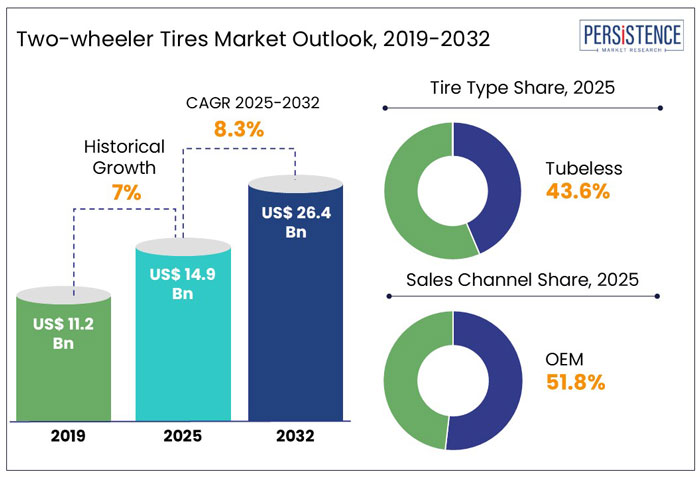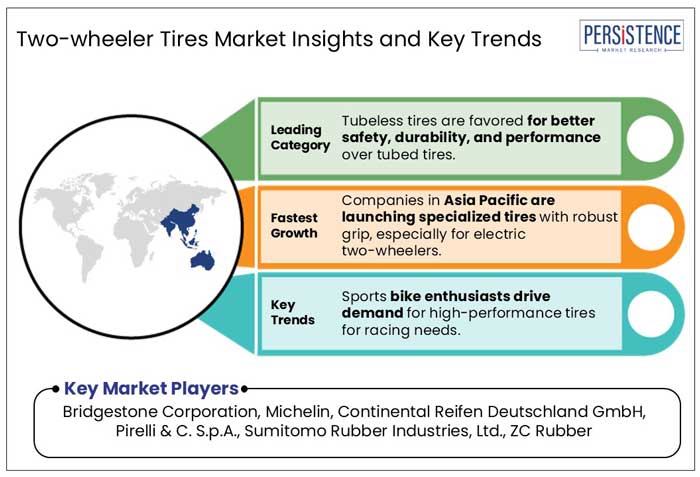Industry: Automotive & Transportation
Published Date: April-2025
Format: PPT*, PDF, EXCEL
Delivery Timelines: Contact Sales
Number of Pages: 182
Report ID: PMRREP35180
The global two-wheeler tires market size is estimated to reach a value of US$ 14.9 Bn in 2025. It is predicted to rise at a CAGR of 8.3% through the assessment period from 2025 to 2032. It will likely attain a value of US$ 26.4 Bn by 2032.
Two-wheeler tires are an essential component that has a direct impact on motorcycle and scooter performance, safety, and efficiency. The choice of tires can have a big impact on the riding experience, from providing the best traction on dry and wet roads to improving fuel efficiency through low rolling resistance. Manufacturers are concentrating on customized designs that accommodate various riding styles, terrains, and environmental circumstances as a result of developments in tire technology.
The requirement for increased stability, durability, and resistance to punctures has led to a recent spike in demand for tubeless and radial tires. Innovative tire models with improved cornering capabilities, higher wet grip, and longer tread life are being introduced by brands such as Michelin, Pirelli, and CEAT. For example, the CEAT Gripp XL is designed for off-road enthusiasts looking for improved traction in rugged terrains, while Michelin Road 6 radial tires offer outstanding stability for sport-touring motorcycles.

Key Highlights of the Two-wheeler Tires Industry
|
Global Market Attributes |
Key Insights |
|
Market Size (2025E) |
US$ 14.9 Bn |
|
Market Value Forecast (2032F) |
US$ 26.4 Bn |
|
Projected Growth (CAGR 2025 to 2032) |
8.3% |
|
Historical Market Growth (CAGR 2019 to 2024) |
7.0% |
From Production Halts due to COVID-19 to Tire Premiumization, Historical Period Saw Ups and Downs
As per Persistence Market Research, in the historical period between 2019 and 2024, the global two-wheeler tires industry showcased a CAGR of 7.0%. Between 2019 and 2020, the market saw average growth as the COVID-19 pandemic resulted in supply chain issues and a decline in two-wheeler sales.
Demand for OEM tires, for instance, was directly impacted by an 18% drop in two-wheeler sales in India year over year. During the lockdown, MRF and CEAT reported fewer revenues, while Michelin and Bridgestone were compelled to temporarily halt manufacturing.
In 2021, as the market rebounded, electric two-wheelers witnessed a high demand, especially in Asia Pacific and Europe. The need for specialty EV tires surged after Ola Electric entered India’s market, forcing producers like TVS Eurogrip to create low rolling resistance types.
Demand for long-lasting and high-mileage tires like the CEAT Milaze and Apollo ActiGrip series further surged with the expansion of last-mile delivery services. These were driven by businesses like Swiggy, Zomato, and Gojek.
Premium radial tires saw considerable growth between 2023 and 2024, mainly in the high-performance motorcycle segment. Metzeler and Pirelli broadened their presence in the U.S. and Europe to supply tires to leading companies like KTM and Ducati. During this period, Michelin’s City Pro tires and Bridgestone’s ECOPIA series also gained popularity due to their fuel-saving features.
Forecast Period to See Launch of High-mileage Tires for Ride-sharing Segment to Lower Tire Degradation
The global market will likely witness a CAGR of 8.3% in the forecast period from 2025 to 2032. Rapid developments in ride-sharing services worldwide are anticipated to propel two-wheeler tires demand through 2032. Companies like Uber Moto, Grab, and Rapido mainly rely on scooters and motorcycles for passenger transport, leading to frequent tire replacements and high wear.
In contrast to private two-wheelers, ride-sharing motorcycles are used for longer periods of time and typically travel between 100 and 200 kilometers each day. Compared to privately owned two-wheelers, this results in faster tire degradation and more frequent replacements. Companies are anticipated to launch high-mileage tires mainly for this segment in the foreseeable future.
High-performance Tires to Witness Rising Demand as Popularity of Motorcycle Sports Surges
The development of new tire technologies is a key factor pushing the two-wheeler tires market growth. Performance tires, particularly sports tires, are the fastest-growing category in the global market.
The need for specialized performance tires has increased for high-performance motorbikes, racing, and sports bikes as riders look for greater speed, handling, and precision in their experience. These tires are designed with high-grip compounds and innovative tread patterns to maximize traction and stability, especially at high speeds and corners.
Rising popularity of motorcycling as a leisure and professional sport, as well as the need for better performance among enthusiasts, are key reasons driving demand for performance tires. These tires are gaining traction in Europe, North America, and some parts of Asia Pacific where motorcycle racing competitions and sports bike adoption are common. Key players are capitalizing on this trend by launching new high-performance tires to cater to varying demands.
In January 2025, for example, Apollo Tyres Ltd., based in India, launched a brand-new line of Vredestein Superpasso high-performance road bike tires. The new lineup aims to satisfy the demands of both competition racers and riders who prioritize performance.
Increased speed, improved resistance to punctures, and enhanced grip and feel are a few features of these tires. As several other manufacturers continue to develop such new products for both professional and recreational riders, the market is projected to witness steady growth.
Environmental Concerns Linked to Natural Rubber Cultivation to Create Challenges in Tire Manufacturing
Natural rubber is an essential component in tire manufacturing, and its supply relies heavily on agricultural variables as well as geographic location. Rubber is grown on around 14 Mn hectares worldwide, as per Regenerative Rubber Initiative.
Natural rubber production is associated with deforestation. Monoculture production also causes biodiversity loss and soil erosion, which are serious ecological issues. Shortage of raw materials has created considerable price fluctuations in the market. Unpredictability in raw material supply may also affect manufacturing schedules, resulting in delays and potential tire shortages in the market.
The situation can become worse with rising global demand for rubber from other industries such as construction and healthcare, resulting in intense competition for limited resources. To solve these issues, producers are looking into alternatives like synthetic rubber, recycled materials, and sustainable manufacturing techniques. However, adopting these solutions may take time and incur additional costs, thereby leading to market hindrances.
Manufacturers to Focus on Specialized Tires with Low Rolling Resistance for Electric Two-wheelers
Increasing shift of individuals toward electric two-wheelers due to environmental benefits and lower running costs is anticipated to create new growth avenues in the market. These two-wheelers operate differently from traditional motorcycles and scooters, with features like faster torque delivery, lighter frames, and a focus on energy efficiency. These factors necessitate the development of specialized tires for these two wheelers to optimize performance and durability.
Specialized tires are designed to provide low rolling resistance, which improves battery efficiency and increases the range of electric two-wheelers. Furthermore, these tires are engineered to resist the added weight of batteries without sacrificing performance or safety.
Enhanced grip, durability, and noise reduction are also important aspects, as electric two-wheelers are often quieter and operate in a variety of urban settings. The need for specialized tires for these two wheelers will likely rise in the foreseeable future as more individuals focus on environmental sustainability.
Tubeless Tires to be Highly Preferred due to Enhanced Stability and Puncture Resistance Features
Tubeless tires are anticipated to generate a two-wheeler tires market share of nearly 43.6% in 2025. These tires have become immensely popular due to their improved safety characteristics, since these are less prone to abrupt deflation during punctures, giving riders greater control and stability. Their lightweight nature enhances fuel efficiency and vehicle performance.
In addition to safety, tubeless tires are highly durable and require less maintenance. These are less likely to experience pinch flats, which are a common problem with tubed tires. Pinch flats are mainly caused by external pressure that significantly damages the inner tube.
Tubeless tires are also easier to repair as these only require sealants or rapid repair kits rather than the removal of the complete tire. Hence, riders who seek hassle-free maintenance find this convenience feature appealing.
Leading companies are focusing on launching new tubeless tires to strengthen their position in the segment. Royal Enfield, for example, introduced tubeless tires for Himalayan 450 in September 2024 after receiving criticism over lack of these tires in its previous models. Current owners can easily upgrade to these tires by paying a certain amount, whereas new buyers can avail this option during the purchase.
Tubed tires, on the other hand, are projected to see average growth in the forecast period. Even though demand is declining with rising shift toward tubeless tires, tubed tires are set to see sales across rural areas among price-sensitive customers. Areas with underdeveloped road infrastructure and rough terrains are projected to see the adoption of tubed tires backed by their ability to handle heavy loads and high shock absorption.
Increasing Customer Trust in Factory-installed Tires to Support OEM Segment
By sales channel, the Original Equipment Manufacturer (OEM) segment is projected to remain at the forefront. It will likely generate a share of around 51.8% in 2025. Manufacturers of motorcycles and scooters have developed long-lasting partnerships with tire companies to guarantee the smooth integration of tires with their models, maximizing both performance and safety.
For Hero MotoCorp's Splendor series, for instance, MRF provides factory-fitted tires, guaranteeing durability and a consistent ride experience. Similarly, TVS Motor Company and Bajaj Auto's main OEM suppliers are TVS Eurogrip and CEAT, respectively.
Bulk procurement, which allows tire producers to maintain consistent production volumes and attain cost effectiveness, is a key benefit of the OEM channel. In addition, as consumers are more inclined to replace their worn-out tires with the same brand that was initially installed on their two-wheeler, OEM tires benefit from pre-existing consumer trust.
The aftermarket sales channel, on the other hand, is anticipated to witness considerable growth through 2032. High demand for replacements is likely to boost the segment. The aftermarket relies on tire replacement cycles, which typically occur every 15,000 to 40,000 kilometers, depending on riding conditions and tire quality, unlike OEM sales, which are reliant on the production of new two-wheelers.

Manufacturers in India and China to Launch Affordable and Long-lasting Tires for Electric Two-wheelers
Asia Pacific is projected to hold a share of around 32.3% in 2025. The region is considered to have one of the most prominent two-wheeler tires industries. In countries like Thailand, the Philippines, Indonesia, and India, motorbikes and scooters are the main forms of mobility, especially in crowded cities where affordability and traffic congestion are big issues.
Approximately 12.7 Mn motorcycles and scooters were sold in Southeast Asia in 2023, found a latest study. The rising rate of two-wheeler adoption is projected to fuel demand for tires, particularly street tires made for city commuting.
The growing popularity of electric two-wheelers is also pushing the regional market, raising demand for specialty tires with maximum energy efficiency. Electric two-wheelers hold immense potential for India and China in addressing climate change and accelerating their transition to a sustainable future. By providing reasonably priced, long-lasting, and performance-focused tires for these two wheelers, manufacturers in Asia Pacific are set to help meet the varying needs of customers.
Traffic Congestion in the U.S. to Propel Demand for Compact Two-wheelers, Boosting Tire Requirements
In North America, the U.S. two-wheeler tires market is anticipated to showcase steady growth through 2032. People in the country tend to spend an excess of their income on motorcycles. In the last 12 years, motorcycle registrations in the country have surged to 6,678,958 in 2006
from 3,826,373 in 1997, revealed the Bureau of Transportation Statistics. This rise highlights a total increase in tire demand in the motorcycle segment.
The roads in cities like New York and Los Angeles are congested. The current infrastructure cannot keep up with the demands of every street and lane due to the rising number of automobiles.
People's productivity is hampered by traffic congestion since they spend a lot of time waiting. As they take up less space and cause minor traffic delays, two-wheelers are becoming immensely popular in the U.S. The adoption of e-bikes is on the rise and tire manufacturers are focusing on investing in lightweight yet safe tires for these bikes.
Grants and Subsidies in Europe to Encourage Consumers to Choose Electric Two-wheelers, Propelling Tire Sales
Europe is witnessing a higher adoption rate of two-wheelers compared to four-wheelers as these are considered ideal to commute through crowded urban areas. Governments of a few countries like the U.K., Germany, and France are focusing on promoting the adoption of electric two-wheelers by moving away from gas-powered scooters. They are doing so to enhance the air quality and lower pollution levels.
Similar government initiatives are projected to propel the adoption of electric two-wheelers, thereby boosting the need for innovative tires. Local manufacturers are also set to launch eco, flat run, and anti-skid tires with improved grips to enhance both driving experience and safety.
The global two-wheeler tires industry is highly competitive, with the presence of both regional and international players. International companies lead the market through their exclusive and extensive product portfolios. These players focus on creating high-quality tires with superior performance, safety, and durability features to cater to the diverse needs of motorcycles, scooters, and electric two-wheelers companies.
Regional manufacturers, on the other hand, are focusing on affordability to target price-sensitive markets. The global market is also characterized by strategic alliances, mergers, and acquisitions as organizations seek to increase their global footprint and technological capabilities.
|
Report Attributes |
Details |
|
Historical Data/Actuals |
2019 to 2024 |
|
Forecast Period |
2025 to 2032 |
|
Market Analysis Units |
Value: US$ Bn/Mn, Volume: As applicable |
|
Geographical Coverage |
|
|
Segmental Coverage |
|
|
Competitive Analysis |
|
|
Report Highlights |
|
|
Customization and Pricing |
Available upon request |
By Tire Type
By Vehicle Type
By Tire Structure
By Application
By Sales Channel
By Region
To know more about delivery timeline for this report Contact Sales

The market is set to reach US$ 14.9 Bn in 2025.
The industry is projected to attain a value of US$ 26.4 Bn by 2032.
The industry is likely to rise at a CAGR of 8.3% through 2032.
Bridgestone Corporation, Michelin, Continental Reifen Deutschland GmbH, and Pirelli & C. S.p.A. are a few key players.
Tubeless tires are the most preferred type worldwide.